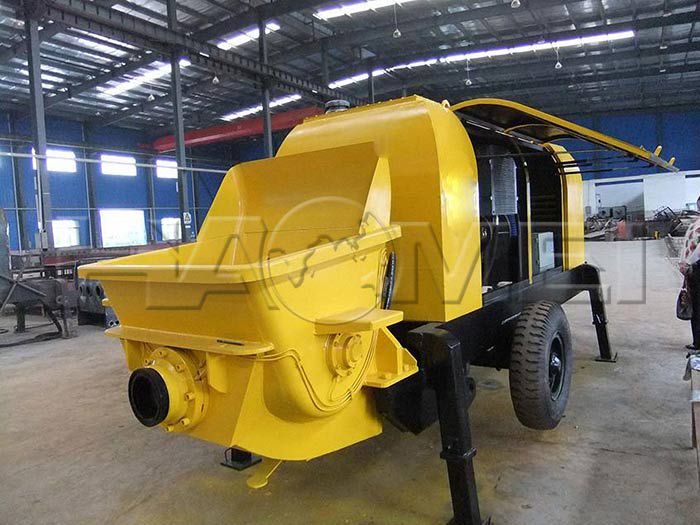Concrete conveying equipment is a commonly used equipment in construction projects for transporting concrete to construction sites. Its quality directly affects the efficiency and quality of construction. Therefore, how to judge the quality of concrete pump trailer is very important. There are three tips to help you judge it:

1. Judgment based on appearance. A high-quality concrete pump should have a neat appearance, with smooth welding parts and no obvious flaws or cracks. At the same time, the equipment should be painted evenly, with bright colors, and without paint peeling or rust. These are the basic requirements for appearance. If the appearance does not meet the standards, it probably means that the quality of the equipment is not up to par.
2. Judge based on performance. A high-quality fine stone concrete pump should have the characteristics of stable conveying capacity, long conveying distance, high pumping height, and fast pumping speed. During use, there should be no problems such as clogging, material leakage, water leakage, etc. The operation is simple and convenient, and the maintenance cost is low. In addition, the equipment should have low noise, small vibration, and work stably and reliably. Only in actual use, these performance indicators meet the requirements can it mean that the quality of the equipment is good.
3. Make a judgment based on accessories and raw materials. A high-quality concrete pump should use high-quality accessories and materials, such as imported hydraulic components, electrical components, etc., to ensure the stability and durability of the equipment. At the same time, the key components of the equipment should be precision processed and tightly assembled to ensure the working efficiency and safety of the equipment. If the accessories and materials of the equipment are not up to standard, it is likely to increase the failure rate of the equipment and affect the construction progress.
CONCRETE PUMPING ADVANTAGES
1. Efficient and fast: Pumping equipment can quickly transport concrete to the construction site, greatly improving construction efficiency. It avoids the tedious process of manual handling or lifting of concrete in traditional methods, reducing the consumption of labor and time.
2. Stable concrete quality: It can ensure the quality uniformity and stability of concrete. During the pumping process, the concrete flows in the pipeline, reducing the possibility of segregation and delamination, ensuring the uniformity of the concrete.
3. Strong adaptability: For some projects with complex terrain and limited construction space, such as high-rise buildings, tunnels, etc., pumping can easily transport concrete to hard-to-reach locations.
4. Low labor intensity: Construction workers no longer need to undertake heavy physical labor, thus reducing labor intensity and improving work safety and comfort.
5. High construction efficiency: The position and amount of concrete pouring can be accurately controlled to ensure the accuracy and standardization of construction.
6. Cost savings: Although the initial equipment investment may be higher, in large-scale construction, labor costs can be reduced and construction efficiency improved, thereby reducing overall project costs.
7. Environmentally friendly: It reduces dust and noise pollution at the construction site and helps protect the environment.
8. Improved concrete quality: The quality of concrete pouring is ensured, thereby improving the quality and reliability of the entire project.
9. Good for large-scale production: t can meet the needs of large-scale projects for concrete transportation and ensure the smooth progress of construction progress.
10. Ease of management: Centralized management and deployment of concrete supply can be achieved, improving management efficiency at the construction site.
PUMPING CONCRETE HAS THE FOLLOWING REQUIREMENTS FOR CONCRETE PERFORMANCE
1. Good pumpability: Concrete needs to have the right slump and flow to flow smoothly in pipes without clogging or segregation.
2. Stability: During the pumping process, the concrete should maintain stable performance and should not have problems such as delamination and bleeding.
3. Viscosity: It must have a certain degree of viscosity to reduce slippage and separation in the pipeline.
4. Water retention: able to maintain a certain amount of moisture and avoid premature drying and shrinkage.
5. Condensation time: adapt to construction requirements, neither condensation too fast nor non-condensation for too long.
6. Strength and durability: Meet design requirements and have sufficient strength and durability.
7. Adaptability: Able to adapt to different pumping conditions and construction environments.
8. Homogeneity: The performance of each part should be as uniform as possible to avoid local defects.
9. Economic rationality: Reduce costs as much as possible while meeting performance requirements.
10. If you like to find concrete pumps for sale near me, welcome to contact us.
Original source: https://www.concrete-pump-cn.com/a/concrete-conveying-equipment-and-concrete-pumping-requirements.html

没有评论:
发表评论